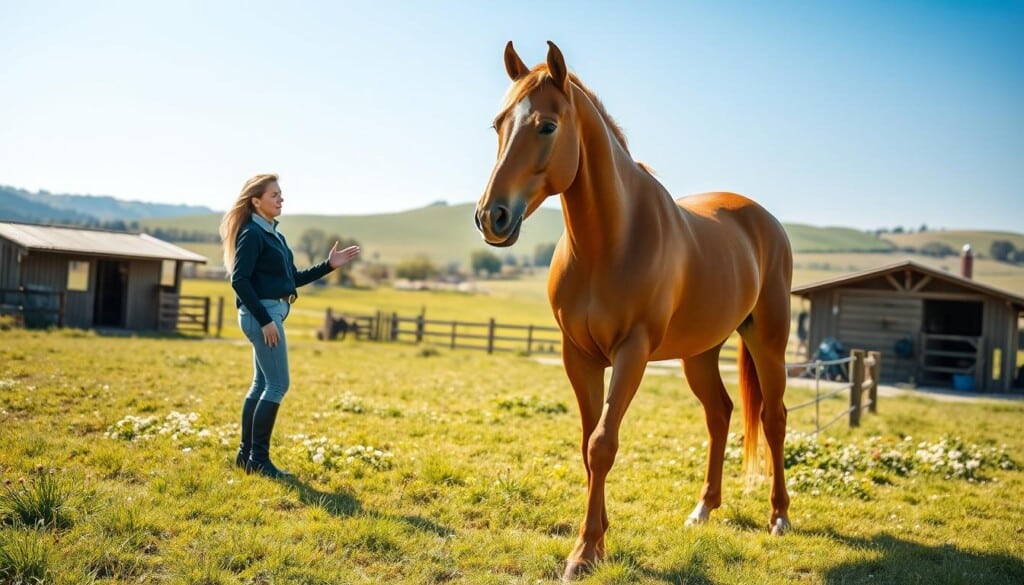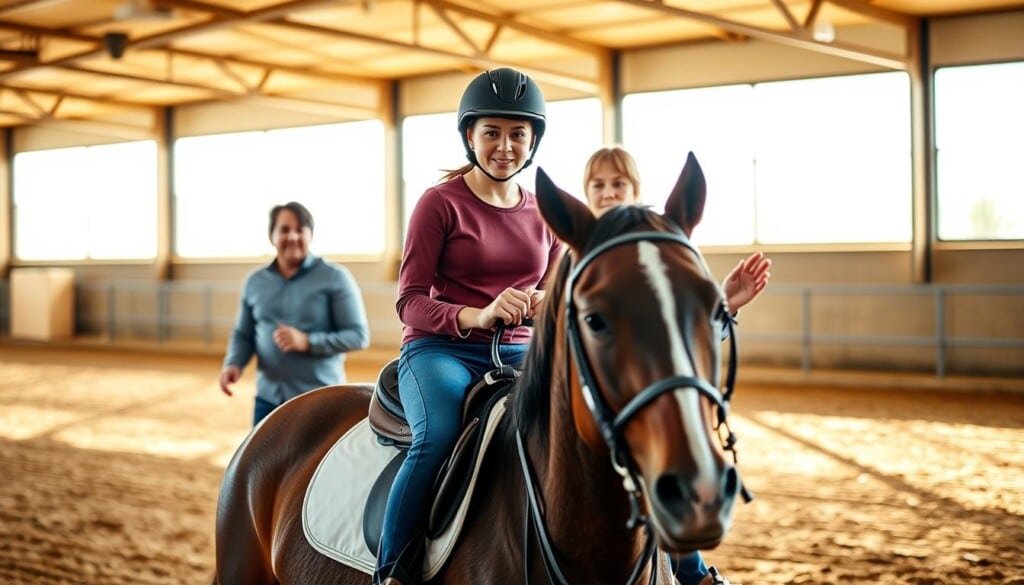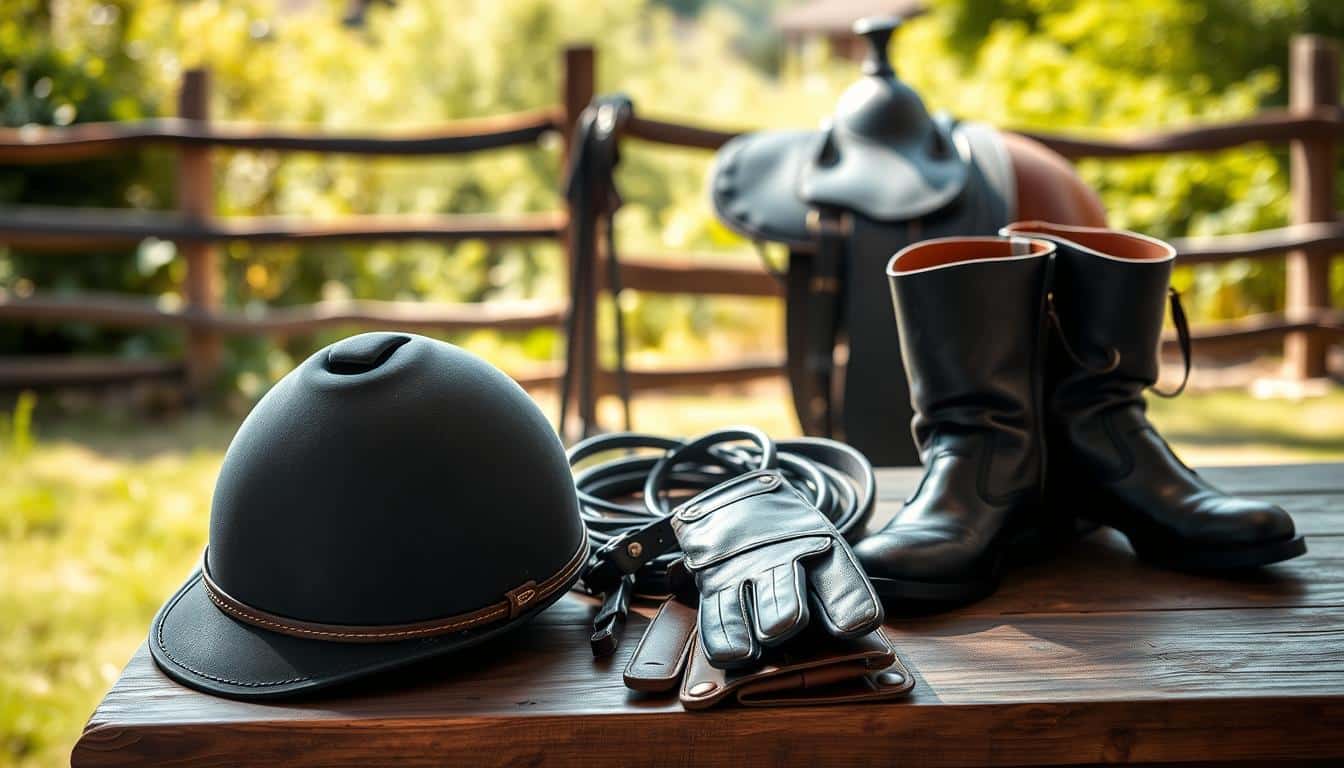Ever thought about what it takes to start an exciting horseback riding journey? Horseback riding comes with its own set of challenges and rewards. It’s key for beginners to know the basics before they ride.
This section is your introduction to the essential horse riding gear and tips. These will keep you safe and make your riding experience better. Learning about safety, choosing the right gear, and riding techniques is important. It sets the stage for a great horseback riding adventure.
Key Takeaways
- Understanding the fundamentals is key for successful horseback riding.
- Proper gear enhances safety and enjoyment in equestrian activities.
- Preparation is key when considering riding lessons.
- Exploring different riding styles helps identify personal preferences.
- A supportive community can enhance the learning experience.
Understanding Horseback Riding
Horseback riding offers many techniques and experiences. It boosts physical fitness and emotional well-being. It also helps build confidence and social skills.
The Benefits of Horseback Riding
Riding a horse is great for your body and mind. It improves balance, coordination, and strength. It also lowers stress levels.
Connecting with a horse is special. It builds trust and companionship. This makes the ride fun and rewarding.
Different Riding Styles Explained
There are many horseback riding styles. English riding is about precision and control. Western riding is about relaxing and responding naturally.
Knowing these styles helps riders choose what suits them best. It depends on their interests and goals.
Safety Considerations for Beginners
New riders need to focus on safety. Wearing a helmet is key to avoiding head injuries. Knowing horse behavior and creating a safe space is also important.
Being aware of your surroundings is vital. It helps you handle any challenges on the trail.
Essential Gear for New Riders
Starting your horseback riding journey means picking the right gear. Safety and comfort are key for beginners. Essential riding equipment helps ensure a good experience.
Riding Helmets: Protection First
Horseback riding helmets are a must-have. They protect your head during falls. Look for helmets that meet ASTM and SEI standards.
Choose a helmet that fits well but isn’t too tight. There are many styles to pick from. You can find one that looks good and keeps you safe.
Choosing the Right Riding Boots
Riding boots are important for stability and comfort. Brands like Ariat have many options for new riders. A good pair has a smooth sole and a heel for better footing.
Try on different boots to find the best fit. The right boots can make a big difference in your riding.
Must-Have Tack and Equipment
Knowing what tack you need is important for beginners. You’ll need saddles, bridles, and saddle pads. A good saddle is key for comfort and safety.
Learn how to pick these items carefully. They should meet safety standards and be comfortable for both you and your horse. Quality tack is worth the investment.
Selecting the Right Horse
Choosing a horse can seem daunting, even for newcomers. It’s key to understand horse breeds information to find the perfect match. Each breed has unique traits, so it’s important to pick one that fits your needs.
Popular breeds like the Arabian, Quarter Horse, and Thoroughbred suit different riding styles. Beginners should look for breeds known for being gentle and easy to train.
Understanding Horse Breeds
Horse breeds vary in size, temperament, and riding suitability. For novices, breeds like the American Paint Horse and Morgan are great. They are known for being calm and versatile.
Looking into horse breeds information helps new riders find the right fit. It’s about matching your riding goals, experience, and comfort level with a breed.
Age and Temperament Considerations
Age and temperament are key when choosing a horse. Younger horses are full of energy, needing more experienced riders. Older horses are often calmer, providing a steadier ride.
It’s important to consider the horse’s age and behavior. Pay attention to how it responds to commands during your first interactions.
How to Test Ride a Horse
Test riding tips are essential in choosing the right horse. It’s wise to try out several horses to find the best fit. While test riding, observe the horse’s response to commands and how comfortable it makes you feel.
A good test ride builds rapport and checks if the horse’s personality matches yours. This is a key step in finding the right horse.

Basic Riding Techniques
Learning basic riding techniques is key to riding well. Beginners should learn safe ways to get on and off the horse. They also need to know how to control the horse for a fun ride.
Communication with the horse is all about rhythm and balance. This makes the rider feel more confident and the horse more responsive. Knowing common riding commands helps the rider guide the horse better.
Mounting and Dismounting Safely
Safe mounting and dismounting are very important. Always approach the horse calmly and speak softly to avoid scaring it. When getting on, make sure the horse is standing steady and use a mounting block if needed.
Getting off the horse also needs care. Lean forward a bit to avoid falling. These steps help prevent injuries for both the rider and the horse.
Establishing Control and Rhythm
Good horse control comes from clear communication and rhythm. Riders should feel the horse’s movements and adjust their position and weight. This balance helps keep control and makes the ride more comfortable.
Using leg pressure and alternating cues helps the horse respond better. This builds a strong bond between the rider and the horse.
Common Riding Commands
Knowing common riding commands is very helpful for beginners. These commands are key for controlling the horse. Basic ones include “walk,” “trot,” “canter,” and “whoa.”
Using these commands consistently helps the rider communicate clearly. The more skilled the rider becomes, the more confident they will feel. This confidence is the first step to a successful riding experience.
Horse Care Fundamentals
Proper horse care is key to keeping these animals healthy and happy. It starts with knowing how to feed, groom, and understand their behavior. These aspects are vital for your horse’s daily life.
Feeding and Nutrition Basics
Good nutrition is essential for a horse’s health. A balanced diet includes hay, grains, and supplements. These are chosen based on the horse’s age, weight, and how active it is. Regular meals keep the digestive system healthy and ensure your horse gets the nutrients it needs.
Grooming: Tools and Techniques
Grooming is more than just making a horse look good. It’s also about their skin health and bonding with you. You’ll need tools like curry combs, brushes, and hoof picks for different tasks. Regular grooming removes dirt, improves blood flow, and lets you check for any health issues.
Understanding Horse Behavior
Knowing how horses behave is important for a strong bond between horse and rider. Paying attention to their body language and sounds can tell you how they’re feeling. This helps you respond in the right way, keeping everyone safe and improving communication.
Riding Lessons: What to Expect
Starting horseback riding can be thrilling but also a bit scary for beginners. Knowing what to expect from riding lessons can make it better. This part talks about finding good riding schools, the pros and cons of private vs. group lessons, and how to check your progress.
Finding a Local Riding School
When looking for a riding school, choose ones with skilled teachers and good reviews. Look for schools that have programs for beginners. This way, you learn the basics in a friendly setting, setting you up for success.
Private vs. Group Lessons
Private and group lessons have their own benefits. Private lessons give you one-on-one time, which means you get feedback and plans just for you. This can help you learn faster. Group lessons, on the other hand, let you meet others and make learning fun together. Think about what you prefer to decide what’s best for you.
Assessing Lesson Progress
It’s key to check how you’re doing in lessons to keep improving and stay motivated. Set goals and talk to your teacher about how you’re doing. Writing down your experiences and achievements can help you see how far you’ve come. Talking to your teacher about your progress can help make your lessons even better.

Building Confidence in the Saddle
Starting out in horse riding is exciting but can also be scary. Getting ready mentally is key. A positive attitude helps manage nerves and grow stronger. Techniques like imagining yourself riding well can make real rides feel easier.
Many riders worry about falling or losing control. It’s important to face these fears. Slowly getting used to riding harder can make you feel less anxious.
It’s also important to celebrate your successes. Every little win, like learning a new command, is worth cheering for. This shows you’re getting better and keeps you motivated.
Community and Social Aspects of Riding
Being part of the riding community makes horseback riding even better. Joining local riding groups helps you make friends and learn new things. You can share stories, get tips, and make friends for life in this supportive space.
Connecting with Local Riding Groups
It’s easy to find local riding groups on social media or community boards. Many areas have strong networks for new riders. These groups are open to everyone, helping you improve and feel more confident.
Benefits of Joining Riding Clubs
Riding clubs offer many benefits. They give you access to special places and training sessions. You can join programs that fit your riding style and skill level. Plus, clubs let you join in on equestrian events, whether you’re competing or just watching.
Participating in Local Events
Local equestrian events are lively places where riders can show off their talents. They help you connect with others who love riding. Whether you’re competing or cheering, these events make your riding experience richer and build stronger community ties.
Connecting with Local Resources
For new riders, finding reliable local resources is key. The LocalZ directory is a great tool for this. It helps connect you with top riding schools, stables, and gear shops. You can filter results by location and services, making it easy to find what you need.
Using LocalZ to Find Riding Businesses
LocalZ makes it easy to find local riding businesses. Whether you need a stable with great instructors or a store for gear, LocalZ has you covered. Its search features help you find what you need quickly, saving you time.
How to Choose a Local Stable
Choosing a local stable is important. Look at the location, facilities, and instructor qualifications. Visiting stables in person can give you a feel for the place. It helps you choose one that fits your riding goals.
Reading Reviews and Ratings
Before choosing a riding business, read reviews and ratings. They offer insights into the strengths and weaknesses of places. LocalZ’s review system helps you understand the reputation of stables and instructors. This way, you can make better choices for your riding.

Supporting Local Businesses
Supporting local businesses makes our community strong. It’s key in the equestrian world, where it builds strong ties. These ties help everyone in the community.
The Impact of Local Spending
Local spending has a big impact. It creates jobs and supports local artists. It also keeps important services in our area.
The equestrian world benefits a lot. Stables and schools can grow and serve their clients better.
How LocalZ Helps Businesses Connect
LocalZ is a big help for local businesses. It connects them with people who need their services. It shows off horseback riding resources and more.
This makes it easier for people to find and support local equestrian services.
Ways to Support Your Equestrian Community
There are many ways to support your equestrian community. Going to local events is a great way to show support. It brings everyone together.
Joining clubs and organizations helps newcomers fit in. Sharing about local services on social media helps more people know about them.
Planning Your Riding Adventures
Starting your horseback riding adventures needs careful planning. Look for local riding trails and parks. These places are great for riders to enjoy nature, learn new skills, and build confidence.
Joining equestrian events can be a thrilling experience. You might compete or just watch. These events highlight equestrian talents and bring people together. Look for upcoming events to meet other riders and learn more about the sport.
If you want to dive deeper into horseback riding, consider a riding retreat. These retreats let you focus on riding while taking a break. You’ll get lessons, go on scenic rides, and relax in a supportive setting.
Continuing Your Riding Journey
For those who love horses, setting long-term riding goals is key. It helps improve skills and grow as a rider. By setting clear goals, like mastering a new technique or joining competitions, riders can grow and achieve more.
Improving riding skills takes hard work and a proactive mindset. Taking advanced lessons, attending workshops, and competing in local shows are great ways to learn. These activities not only make you better but also connect you with the equestrian world.
It’s also important to use many learning resources. Books, online courses, and local mentorship programs can teach you a lot. Seeing horseback riding as a lifelong journey keeps the passion alive and makes your equestrian path richer.

